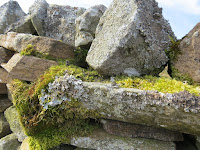Everyone who visits the Yorkshire Dales are fascinated and sometimes bemused when they see the thousands of miles of stone walls that feature so prominently here.
Who built them? How old are they? Where did the stone come from?
The first thing to understand is that the walls are double skinned with a narrow cavity in the middle. The walls are strengthened with three lines of 'through' stones (sometimes pronounced 'truffs'). The through stones transverse the two walls and are left proud of the face of the wall. Through stones are also obvious on the stone buildings (cowhouses) as they are built using the same principle.
So the stones that you see sticking out of the walls and buildings are not:-
a) to make it easy for the farmer to climb over.
b) so that he can scale the face of the cow house to reach the forking hole.
c) or somewhere for him to perch his behind!
Although they may be used for these purposes on occasions!
Winding walls that edge our weaving roads, walls that divide our meadows, that snake their way over the fell and form the boundary between pasture and open moor. These dry stone walls are not only an iconic feature of the Yorkshire Dales but an essential resource for hill farmers in the dales.
GETTING OVER - GETTING THROUGH
Squeeze stiles and ladder stiles provide a place to get over a wall and keep walkers safely on the official path but what about the sheep?
Look closely and you will find all manner of strange openings. These are thru'les (sometimes called smoots or smoot holes) and are gaps in the stone walls that can be quickly opened to let sheep through. Hense thru'le - through hole. Commonly found in walls that divide fields but occasionally seen on roadside walls to allow sheep to move from field to farmstead.
Below, the sheep-shaped thru'le is most unusual. And the stoned-up section of wall on the roadside opposite Pry House Farm is fascinating. Was it once a thru'le or a gateway? Then when longer required, simply and neatly walled up? We can only assume, we will never really know.
NOT JUST A BOUNDARY WALL - OUR WALLS HAVE MANY USES
A place for moss and lichen to thrive.
A hidey-hole for mice and voles.
A place for three hand reared lambs to show off and play!
But perhaps most important of all a sheltered place to lamb and to keep a newborn safe.
Guests staying at Pry House Farm B&B admire our beautifully maintained walls and often want to find out more. The Yorkshire Dales National Park Authority are holding Drystone Walling Demonstrations at the Dales Countryside Museum in Hawes from April to August www.dalescountrysidemuseum.org.uk or have a look at The Yorkshire Dry Stone Walling Guild 2 day non-residentional courses www.ydswg.co.uk.
Then when you come to stay with us we may have a gap or two for you to practise on!
www.upperswaledaleholidays.co.uk
Then when you come to stay with us we may have a gap or two for you to practise on!
www.upperswaledaleholidays.co.uk












No comments:
Post a Comment